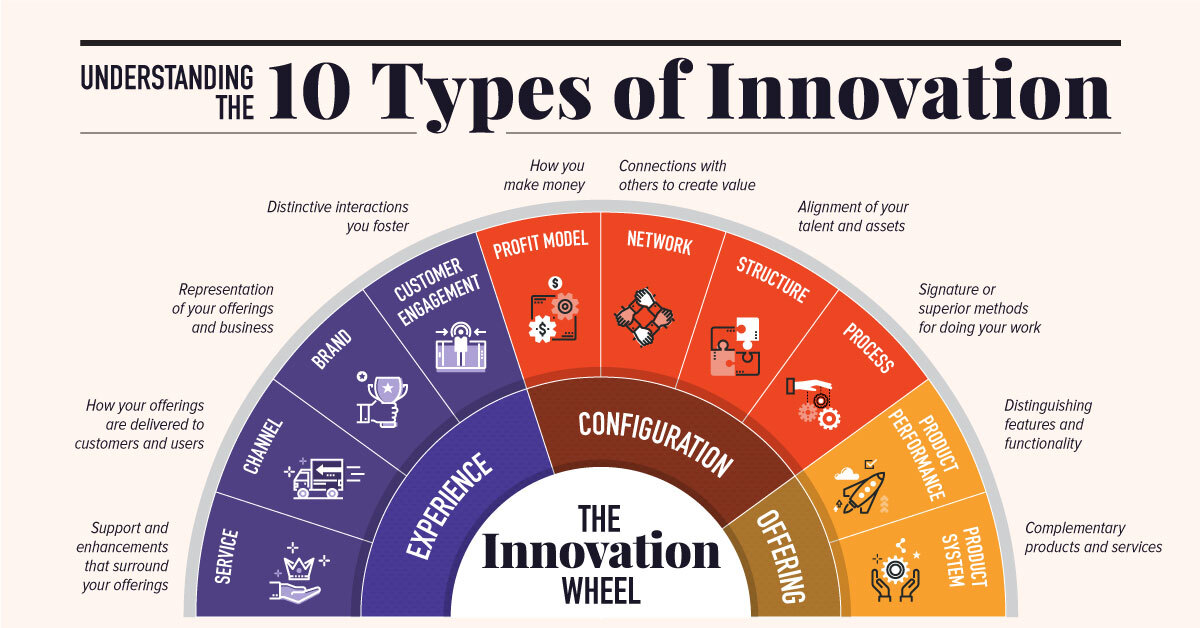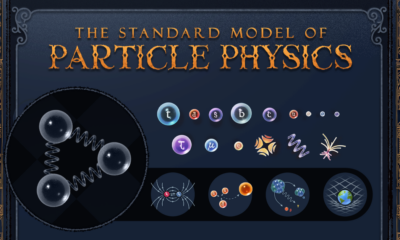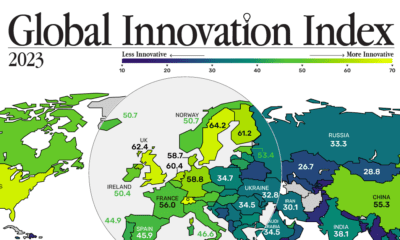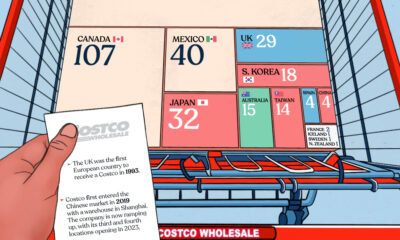Technology
10 Types of Innovation: The Art of Discovering a Breakthrough Product
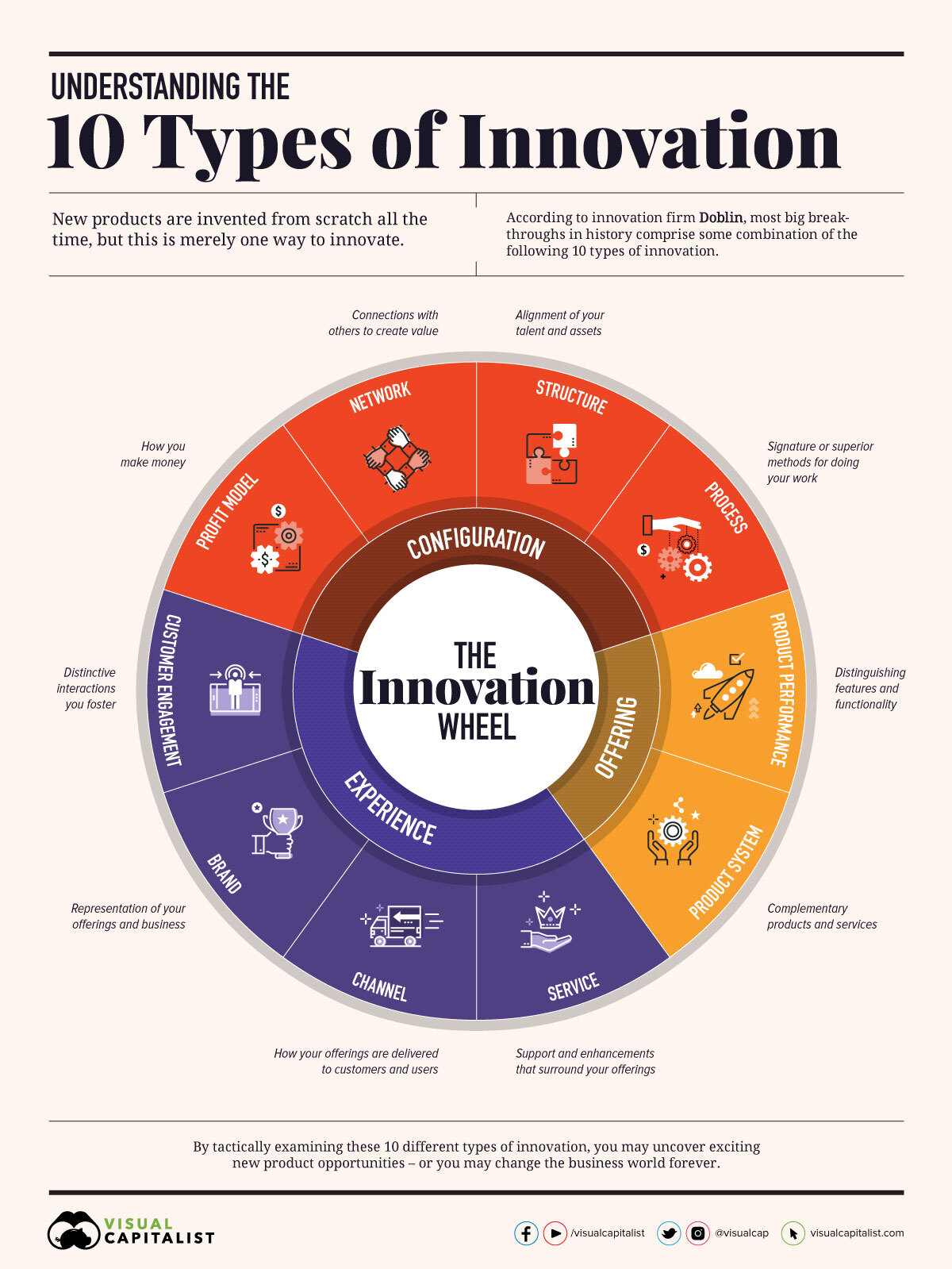
The Art of Discovering Breakthrough Products
As venture capitalist Peter Thiel once put it, “competition is for losers.”
It’s inevitable that every company must be out there battling for market share, but you don’t really want to be in a situation where the competition is so stiff that any potential upside is eroded away in the process—―a scenario known as perfect competition in economics.
To avoid perfect competition, companies must strive to build an economic moat that gives them a sustainable competitive advantage over time. While these protective moats can arise from a number of different sources, in today’s information economy they most often arise from the power of innovation.
But where does innovation come from, and is there a universal framework that can be applied to help consistently make big breakthroughs?
The 10 Types of Innovation
In today’s infographic, we showcase the culmination of years of in-depth research from Doblin, an innovation-focused firm now owned by Deloitte.
After examining over 2,000 business innovations throughout history, Doblin uncovered that most breakthroughs don’t necessarily stem from engineering inventions or rare discoveries.
Instead, they observed that innovations can be categorized within a range of 10 distinct dimensions—and anyone can use the resulting strategic framework to analyze the competition, to stress test for product weaknesses, or to find new opportunities for their products.
Here are the 10 types of innovation:
| # | Innovation Type | Description |
|---|---|---|
| 1. | Profit Model | How you make money |
| 2. | Network | Connections with others to create value |
| 3. | Structure | Alignment of your talent and assets |
| 4. | Process | Signature of superior methods for doing your work |
| 5. | Product Performance | Distinguishing features and functionality |
| 6. | Product System | Complementary products and services |
| 7. | Service | Support and enhancements that surround your offerings |
| 8. | Channel | How your offerings are delivered to customers and users |
| 9. | Brand | Representation of your offerings and business |
| 10. | Customer Engagement | Distinctive interactions you foster |
From Theory to Practice
What does innovation look like in practice?
Let’s see how well-known businesses have leveraged each of these 10 types of innovation in the past, while also diving into the tactics that modern businesses can use to consistently make new product breakthroughs:.
Innovation Types #1-4: “Configuration”
According to Doblin, the first four types of innovation center around the configuration of the company, and all the work that happens “behind the scenes”.
Although innovation types in this category are not directly customer-facing, as you can see in the examples below, they can still have an important impact on the customer experience. How your company and products are organized can have a crucial downstream effect, even enabling innovations in other categories.
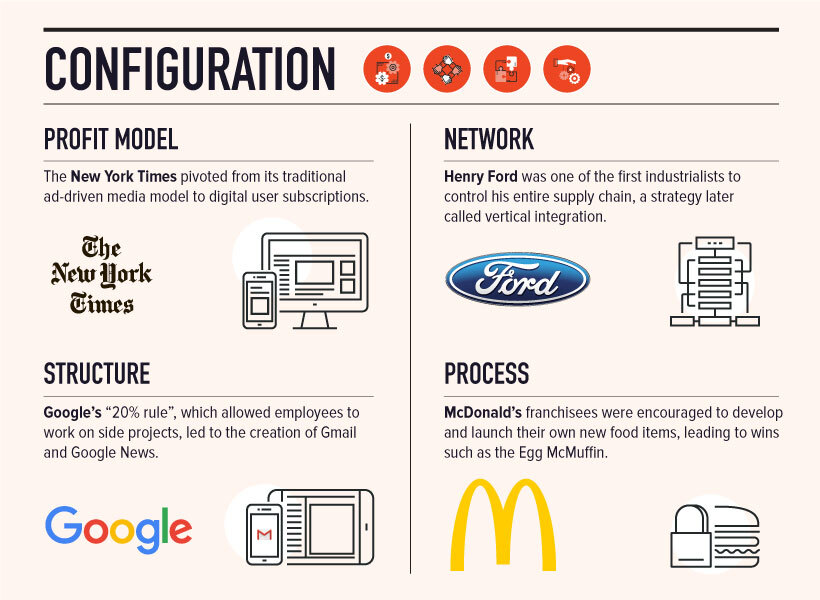
Two of the most interesting examples here are Google and McDonald’s. Both companies made internal innovations that empowered their people to make important advancements further on downstream.
In the case of McDonald’s, the franchisee insight that led to the introduction of the Egg McMuffin spearheaded the company’s entire breakfast offering, which now accounts for 25% of revenues. Breakfast is also now the company’s most profitable segment.
Innovation Types #5-6: “Offering”
When most people think of innovation, it’s likely the offering category that comes to mind.
Making improvements to product performance is an obvious but difficult type of innovation, and unless it’s accompanied by a deeply ingrained company culture towards technical innovation, such advancements may only create a temporary advantage against the competition.
This is the part of the reason that Doblin recommends that companies focus on combining multiple areas of innovation together—it creates a much more stable economic moat.
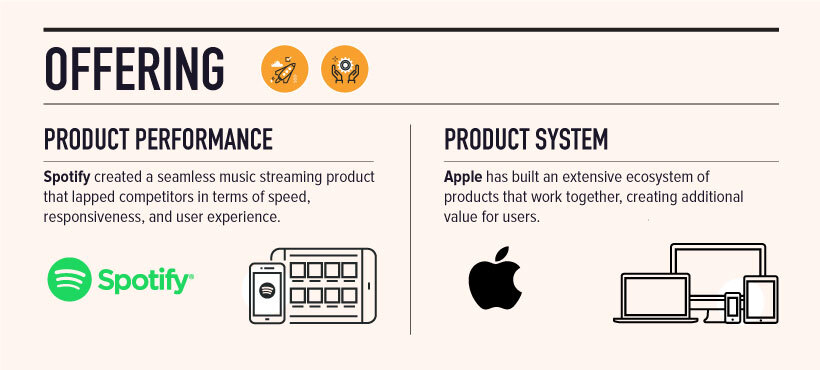
Apple has a reputation for innovation, but the product ecosystem highlighted above is an underappreciated piece of the company’s strategy. By putting thought into the ecosystem of products—and ensuring they work together flawlessly—additional utility is created, while also making it harder for customers to switch away from Apple products.
Innovation Types #7-10: “Experience”
These types of innovation are the most customer-facing, but this also makes them the most subject to interpretation.
While other innovations tend to occur upstream, innovations in experience all get trialed in the hands of customers. For this reason, intense care is needed in rolling out these ideas.
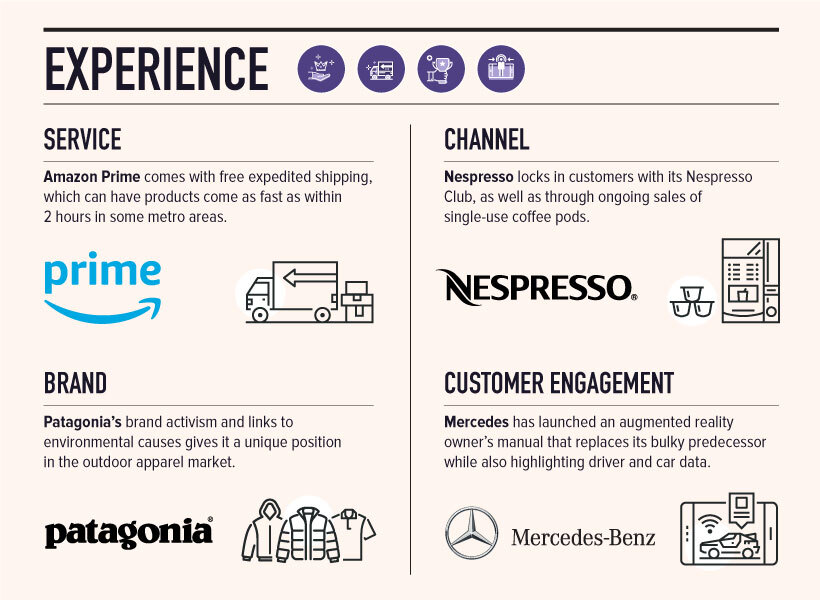
In the early days of the internet, online shipping was precarious at best—but Amazon’s introduction of Amazon Prime and free expedited shipping for all members has been a game-changer for e-commerce.
Executing on such a promise was no small task, but today there are 150 million users of Prime worldwide, including some in metro areas who can get items in as little as two hours.
Making Innovations Happen in Your Organization
How can organizations approach the 10 types of innovation from a more tactical perspective?
One useful resource is Doblin’s free public list of over 100 tactics that correspond with the aforementioned framework.
The one-pager PDF provides a range of typical dimensions for approaching each type of innovation. In essence, these are all different ways you could consider when trying to differentiate your product or service—and at the very least, it provides a useful thought experiment for managers and marketers.
For those interested in learning more on this topic, Doblin also has a highly-rated book as well as other accessories that leverage the above framework.
Technology
All of the Grants Given by the U.S. CHIPS Act
Intel, TSMC, and more have received billions in subsidies from the U.S. CHIPS Act in 2024.

All of the Grants Given by the U.S. CHIPS Act
This was originally posted on our Voronoi app. Download the app for free on iOS or Android and discover incredible data-driven charts from a variety of trusted sources.
This visualization shows which companies are receiving grants from the U.S. CHIPS Act, as of April 25, 2024. The CHIPS Act is a federal statute signed into law by President Joe Biden that authorizes $280 billion in new funding to boost domestic research and manufacturing of semiconductors.
The grant amounts visualized in this graphic are intended to accelerate the production of semiconductor fabrication plants (fabs) across the United States.
Data and Company Highlights
The figures we used to create this graphic were collected from a variety of public news sources. The Semiconductor Industry Association (SIA) also maintains a tracker for CHIPS Act recipients, though at the time of writing it does not have the latest details for Micron.
| Company | Federal Grant Amount | Anticipated Investment From Company |
|---|---|---|
| 🇺🇸 Intel | $8,500,000,000 | $100,000,000,000 |
| 🇹🇼 TSMC | $6,600,000,000 | $65,000,000,000 |
| 🇰🇷 Samsung | $6,400,000,000 | $45,000,000,000 |
| 🇺🇸 Micron | $6,100,000,000 | $50,000,000,000 |
| 🇺🇸 GlobalFoundries | $1,500,000,000 | $12,000,000,000 |
| 🇺🇸 Microchip | $162,000,000 | N/A |
| 🇬🇧 BAE Systems | $35,000,000 | N/A |
BAE Systems was not included in the graphic due to size limitations
Intel’s Massive Plans
Intel is receiving the largest share of the pie, with $8.5 billion in grants (plus an additional $11 billion in government loans). This grant accounts for 22% of the CHIPS Act’s total subsidies for chip production.
From Intel’s side, the company is expected to invest $100 billion to construct new fabs in Arizona and Ohio, while modernizing and/or expanding existing fabs in Oregon and New Mexico. Intel could also claim another $25 billion in credits through the U.S. Treasury Department’s Investment Tax Credit.
TSMC Expands its U.S. Presence
TSMC, the world’s largest semiconductor foundry company, is receiving a hefty $6.6 billion to construct a new chip plant with three fabs in Arizona. The Taiwanese chipmaker is expected to invest $65 billion into the project.
The plant’s first fab will be up and running in the first half of 2025, leveraging 4 nm (nanometer) technology. According to TrendForce, the other fabs will produce chips on more advanced 3 nm and 2 nm processes.
The Latest Grant Goes to Micron
Micron, the only U.S.-based manufacturer of memory chips, is set to receive $6.1 billion in grants to support its plans of investing $50 billion through 2030. This investment will be used to construct new fabs in Idaho and New York.
-

 Education1 week ago
Education1 week agoHow Hard Is It to Get Into an Ivy League School?
-

 Technology2 weeks ago
Technology2 weeks agoRanked: Semiconductor Companies by Industry Revenue Share
-

 Markets2 weeks ago
Markets2 weeks agoRanked: The World’s Top Flight Routes, by Revenue
-

 Demographics2 weeks ago
Demographics2 weeks agoPopulation Projections: The World’s 6 Largest Countries in 2075
-

 Markets2 weeks ago
Markets2 weeks agoThe Top 10 States by Real GDP Growth in 2023
-

 Demographics2 weeks ago
Demographics2 weeks agoThe Smallest Gender Wage Gaps in OECD Countries
-

 Economy2 weeks ago
Economy2 weeks agoWhere U.S. Inflation Hit the Hardest in March 2024
-

 Environment2 weeks ago
Environment2 weeks agoTop Countries By Forest Growth Since 2001
